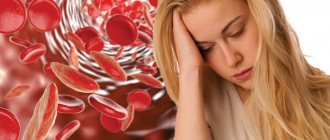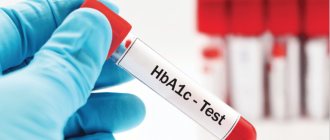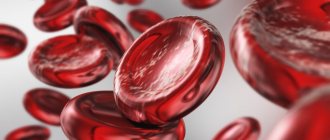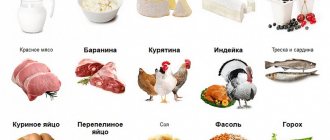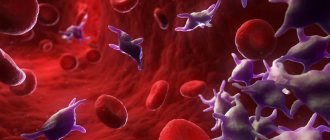Low hemoglobin is not an independent disease. It is the result of an underlying disease, therefore, if anemia is detected in a patient, the doctor is obliged to prescribe a comprehensive examination.
Concepts of pseudoanemia and hidden anemia
Pseudoanemia is the entry of tissue fluid into the bloodstream during the resorption of edema.
Hidden anemia is the result of the loss of a significant part of the fluid composition of the blood due to dehydration (can be caused by diarrhea, vomiting, hyperhidrosis). In this situation, the blood begins to thicken, so laboratory analysis shows that the number of red blood cells and hemoglobin is normal, even if this is not the case.
Severity of anemia
Based on severity, anemia is classified into:
- light. Hemoglobin level is more than 100 g/l, erythrocytes - more than 3 T/l;
- average Hemoglobin level from 66 to 100 g/l, erythrocytes - from 2 to 3 T/l;
- heavy. Hemoglobin level is less than 66 g/l.
Classification of anemia
All anemias manifest themselves differently. Taking into account the cause of the pathological condition and its symptoms, there are four main types:
- posthemorrhagic anemia (caused by chronic/acute blood loss);
- hemolytic anemia (develops due to the destruction of red blood cells). This group includes hereditary hemolytic anemias: - with a lack of glucose-6 phosphate dehydrogenase; - thalassemia; - sickle cell; — Minkowski-Shoffar;
- deficiency anemia (caused by a deficiency of microelements/vitamins/iron, that is, any elements that play an important role in the process of hematopoiesis);
- hypoplastic anemia (results from impaired hematopoiesis in the bone marrow, the most dangerous form).
According to the color indicator of blood, anemia can be:
- normochromic (hemoglobin is normal). This group includes hemolytic and posthemorrhagic anemia;
- hyperchromic (hemoglobin increased). These include folate deficiency and B12 deficiency anemia;
- hypochromic (hemoglobin is low). This refers to thalassemia, iron deficiency and chronic posthemorrhagic anemia.
Based on the diameter of red blood cells, anemia can be:
- normocytic (almost all hemolytic and acute posthemorrhagic anemia);
- megaloblastic (B12-deficiency anemia);
- macrocytic (folate deficiency, hemolytic disease of the newborn);
- microcytic (chronic posthemorrhagic anemia).
Based on the iron content in the blood serum, anemia is divided into:
- normosideremic (acute posthemorrhagic anemia);
- hyposideremic (chronic posthemorrhagic and iron deficiency anemia, thalassemia);
- hypersideremic (hemolytic and B12-deficiency anemia).
What is low hemoglobin?
There are medical standards for hemoglobin content in the blood, different for each age category:
- women over 18 years of age – 115–140 g/l;
- men – 135-160 g/l;
- children from 5 to 12 years old – 115–145 g/l;
- for pregnant women – 100–110 g/l.
Low hemoglobin indicates that the organs are poorly supplied with oxygen; the body does not have enough of such an important trace element as iron. If the problem is not intervened in time, it can develop into a pathology. Cells cannot breathe without hemoglobin, so its content must always be normal.
Drugs that increase hemoglobin in the blood: list
How to increase hemoglobin at home quickly?
Which foods contain a lot of iron to increase hemoglobin?
- Dried mushrooms.
A product that can significantly increase iron levels in the body. Just 50 g of dried mushrooms per day will help replenish the iron content in the blood. Not everyone can eat them every day, but periodically including mushrooms in your diet is very useful.
- Red meat.
The dark color of the product indicates a high iron content. For example, a steamed beef cutlet weighing 100 g contains approximately 2.7 mg of iron - almost 15% of the daily requirement. For comparison: in the same turkey cutlet the amount of iron is about 0.7 mg.
- Pumpkin seeds.
An excellent source of iron: 200 g of the product easily covers the daily requirement. But you shouldn’t get carried away with pumpkin seeds: they are very high in calories and can cause disruptions in the gastrointestinal tract. But a small handful of seeds in a salad or hot dish will be very useful.
- Offal.
In terms of the content of iron and other useful microelements, offal easily surpasses meat. 100 g of cooked beef liver contains 36% of the daily iron requirement.
- Buckwheat and rolled oats.
A couple more important foods that can boost your iron levels. A 100 g serving of buckwheat or rolled oats will provide the body with approximately 25% of the beneficial element.
- Legumes.
An essential part of the diet for vegetarians and vegans, legumes are not only rich in iron, but also very filling. A cup of boiled lentils, for example, will cover approximately 35% of the daily requirement for iron, and a glass of boiled beans will cover 20%.
- Dark chocolate.
Perhaps the favorite product of those who seek to increase their hemoglobin levels. The main thing is to choose chocolate with a cocoa content of at least 70% and eat at least ¼ bar (25 g) per day. This will help compensate for about 17% of the daily iron requirement and give you a good mood due to the “happiness hormone”.
For iron deficiency and low hemoglobin, the following foods are also recommended: eggs (especially the yolk), quinoa, almonds, walnuts, peeled apples, pomegranate, grapes, raspberries, rose hips, beets, freshly squeezed fruit and vegetable juices, seafood - caviar, fish, oysters It is important that the diet is balanced and that foods contain a variety of nutrients and vitamins.
Signs of low hemoglobin
Iron deficiency is manifested by the following symptoms:
- lack of appetite;
- dry flaky skin;
- weak brittle nails;
- lifeless dull hair;
- causeless increase in temperature;
- general loss of strength;
- pale skin;
- the appearance of cracks on the lips;
- cardiopalmus;
- change in taste preferences;
- disruption of the defecation process;
- constant headaches;
- cold extremities, even in a warm room;
- fast fatiguability;
- unpleasant sensations in the legs, when there is a desire to simply move them in order to get rid of the discomfort;
Important! In some cases, low hemoglobin can only be detected after a blood test, since its course does not necessarily have to be accompanied by these symptoms, especially if the decrease differs slightly from the norm. Depends on the body. For prevention purposes, it is important to regularly have your blood tested.
Symptoms of anemia
Conventionally, the symptoms of low hemoglobin are classified into:
- specific (manifest only in specific types of anemia);
- nonspecific (the same for all types of disease).
Nonspecific symptoms of anemia are as follows:
- pallor of the skin/mucous membranes;
- migraine;
- increased fatigue;
- noise in ears;
- refusal of food;
- constant drowsiness;
- feeling of lack of air;
- dizziness;
- cardiopalmus;
- decreased libido, sexual impotence in men;
- disruption of the menstrual cycle;
- heart failure.
Specific signs of different types of anemia
Each type of anemia has its own specific symptoms. Thus, the acute posthemorrhagic form manifests itself:
- increased heart rate;
- fainting;
- cold sweat;
- attacks of dizziness;
- pale skin;
- decrease in body temperature.
In chronic posthemorrhagic anemia the following are observed:
- very white skin;
- craving for or intolerance to certain smells;
- swelling of the face;
- change in taste sensations;
- dry skin;
- brittle nails;
- nausea;
- lack of air;
- sweating;
- involuntary urination when sneezing or laughing;
- temperature increase.
Hemolytic anemias are characterized by:
- yellowness of the skin and mucous membranes (when red blood cells are destroyed, bilirubin enters the bloodstream);
- increased size of the spleen/liver;
- increased levels of bilirubin in the blood;
- darkening of urine and feces;
- high body temperature;
- weakness.
Sickle cell anemia - a type of hemolytic - has the following symptoms:
- jaundice;
- shortness of breath;
- formation of inflamed areas on the legs;
- blurred vision;
- the presence of hemoglobin in the urine.
Doctors diagnose thalassemia if the patient:
- the shape of the skull bones changes;
- the skin becomes very pale with a yellowish/greenish tint;
- eyes become narrow and swollen;
- there is a lag in mental/physical development;
- bones are deformed;
- the spleen/liver enlarges.
Signs of iron deficiency anemia include:
- buzzing in the head;
- lack of oxygen;
- migraine;
- constant desire to sleep, rest;
- dry skin;
- peeling of nails;
- hair section;
- desire to eat chalk, smell paint, etc.;
- violation of the act of urination;
- hyperhidrosis.
Also, during laboratory tests, it is discovered that the level of hemoglobin and red blood cells in the blood is significantly lower than the established norm.
B12 deficiency anemia affects the gastrointestinal tract and central nervous system. As a result, the patient experiences:
- swelling of the legs;
- crawling sensation on the arms/legs;
- change in gait;
- memory impairment;
- problems swallowing food;
- enlarged liver/spleen;
- drying of the gastrointestinal mucosa.
In turn, folate deficiency anemia manifests itself:
- inability to eat acidic foods;
- glossitis;
- difficulty chewing and swallowing food;
- enlarged spleen/liver;
- atrophy of the mucous membranes of the gastrointestinal tract.
The symptoms of hypoplastic anemia are:
- the appearance of ulcers in the mouth, on the skin of the face;
- bruising on the skin;
- severe bleeding gums;
- increased fatigue;
- desire to sleep;
- tachycardia;
- decrease in the number of leukocytes, red blood cells and platelets in a blood test.
If you experience similar symptoms, consult your doctor
. It is easier to prevent a disease than to deal with the consequences.
Why is hemoglobin low?
There is no clear reason. It is impossible to talk about the development of pathology every time the hemoglobin level is below normal. This may be a temporary phenomenon caused by trauma with blood loss, surgery, donation, vegetarian diet, and in women, additionally, the menstrual cycle.
The basis for the development of the disease may be pathological processes occurring in the body:
- digestive problems (colitis, enterocolitis, dysbacteriosis);
- bleeding;
- failure of the immune system;
- infection of the body;
- leukemia, lymphoma;
- uterine fibroids, causing bleeding;
- disease of the hematopoietic system;
- tumors of various origins;
- kidney pathology.
It is important to know! During pregnancy, the hemoglobin level is 30 to 20 units below normal. But this is a temporary phenomenon that goes away after the birth of the child, in the absence of chronic diseases.
Why does the body need hemoglobin?
Hemoglobin provides oxygen transport. In the capillaries of the lungs, a maximum of four oxygen molecules bind to one oxygen molecule and form oxyhemoglobin. Then, in the blood stream, red blood cells deliver this ligament to organs and tissues. Here, the oxygen necessary for oxidative processes is freed from bonding with hemoglobin.
Iron is necessary for the normal functioning of the human immune system. A lack of this microelement can lead to problems with potency in men and disrupt the menstrual cycle in women. Low hemoglobin levels can also warn of other serious diseases.
Signs of iron deficiency in the body may include loss of energy, depression, hair loss and dry skin, drowsiness and irritability. However, to determine true anemia and replenish iron deficiency, it is necessary to conduct a detailed blood test.
At risk are vegetarians and fans of strict diets, teenagers during hormonal changes in the body, and child athletes who do not take additional vitamin and mineral complexes. If pregnant women do not take special multivitamins, they are also at risk of developing anemia.
The doctor reminds you that you should not buy drugs to replenish hemoglobin and ferritin reserves at the pharmacy yourself. They are prescribed only by doctors. In addition, the effect of the drugs begins only after six months and therefore the course of treatment cannot be interrupted.
What are the consequences if low hemoglobin is not treated?
Oxygen delivered by hemoglobin ensures the normal functioning of all organs. If it is not enough, then functional and organic changes begin, resulting in a life-threatening condition. The degree of damage depends on the duration of oxygen starvation, and the consequences lead to the formation of a number of pathologies:
- painful changes in the liver;
- development of shortness of breath;
- the appearance of pathological changes in the vascular and cardiac systems;
- disruptions in the functioning of the nervous structure;
- changes in the composition of the blood, a decrease in red blood cells - anemia;
- development of atherosclerosis;
- exacerbation of chronic diseases.
A slight decrease in hemoglobin relative to the norm is associated with weakness and increased fatigue. As the gap in indicators increases, a depressive state and irritability appear.
Note! A large lack of hemoglobin in pregnant women is fraught with premature birth and the development of hypoxia in the unborn child.
Hematologist: who is he, for what symptoms and diseases should you make an appointment with a doctor?
Table of contents
- Hematologist: what does it treat?
- Pediatric hematologist: who is he and what does he treat?
- Help from a hematologist during pregnancy
- When to go to a hematologist?
- Preparing for a consultation
- Blood tests to be taken before consultation
- Stages of consultation with a hematologist
- Diagnostics
- Treatment
- Advantages of visiting a hematologist at MEDSI
A hematologist is a doctor who deals with the prevention, diagnosis and treatment of diseases of the blood and hematopoietic organs.
This specialist works with children and adults and uses both traditional and modern techniques in his practice. It can successfully identify even hidden pathologies that do not manifest significant symptoms.
Hematologist: what does it treat?
These specialists provide therapy for the following diseases:
- Anemia.
This pathology is characterized by a decrease in red blood cells and hemoglobin. Anemia is not a separate disease! This is a symptom of mycosis, pyelonephritis, tuberculosis and other dangerous conditions. It is usually accompanied by weakness, general malaise, appetite and sleep disturbances, shortness of breath even with moderate exertion, and poor concentration. - Lymphocytic leukemia.
This disease is malignant and is characterized by the proliferation of atypical B lymphocytes that accumulate in the bone marrow, spleen, liver and lymph nodes. A predisposition to the pathology is inherited, and its main symptoms include enlarged lymph nodes, excessive sweating, weakness and sudden weight loss. As lymphocytic leukemia develops, an enlarged spleen and liver, anemia, dizziness, and spontaneous bleeding are detected - Multiple myeloma.
This pathology is malignant and is distinguished by the ability of tumor cells to synthesize homogeneous immunoglobulins or their fragments. The tumor is formed predominantly in the bone marrow and can be focal, diffuse or focal-diffuse - Myeloid leukemia.
This form of leukemia is characterized by the rapid division of special cells in the bone marrow and their accumulation in the blood. Usually it is diagnosed only during a clinical analysis, since often the pathology does not manifest itself in any way. In some cases, patients complain of a slight increase in body temperature, decreased immunity and general malaise. It is also possible to detect anemia and an enlarged spleen - Lymphomas.
This pathology is characterized by enlarged lymph nodes. The primary tumor site usually metastasizes and spreads throughout the body. There are several forms of lymphoma, which differ in symptoms and degree of malignancy.
Specialists also treat other diseases.
Pediatric hematologist: who is he and what does he treat?
This specialist deals with the treatment and prevention of diseases that occur in both children and adults. Working with patients under 18 years of age, he takes into account all the features of their age and development.
They are referred to such doctors if they suspect various forms of anemia, thrombocytopenia (decreased platelet count), hemorrhagic vasculitis (inflammation of microvessels), hemophilia and other congenital hereditary disorders.
Important! If blood diseases are detected at an early age, the patient should be under medical supervision for as long as possible. It is very important not only to detect pathology, but also to control it. Only in this case can the correct growth and development of the child be ensured.
Help from a hematologist during pregnancy
A large number of blood diseases are inherited, for this reason it is very important to visit a doctor when planning a child and during pregnancy. The specialist will provide the necessary genetic tests and determine the likelihood of developing abnormalities. It is especially important to contact a hematologist if one or both future parents have pathologies.
In addition, it is very important for a pregnant woman to monitor all blood parameters, since the supply of oxygen and other nutrients to the fetus largely depends on them. Consultation with a doctor is required for various deviations from the norm. It is especially important to quickly seek medical help if you suspect the development of iron deficiency anemia. This problem is one of the most common and needs correction and observation until birth.
When to go to a hematologist?
Consultation with a doctor is required for the following signs of various disorders:
- Enlarged lymph nodes
- Weakness and drowsiness
- Increased body temperature (not due to colds and inflammatory processes)
- Weight loss
- Sleep disorders
- Excessive sweating
- Pale skin
- Decreased appetite
- The appearance of bruises on the body without objective reasons
- Dizziness
Help is required for patients who complain of joint pain, itching, dry skin, tingling and numbness of the fingers. You should make an appointment with a hematologist if you have a hereditary predisposition to blood diseases and low hemoglobin detected as part of a general diagnosis. Both general practitioners, gastroenterologists, neurologists and other doctors can refer you to this specialist.
Preparing for a consultation
No special preparation is required for the standard appointment. Some restrictions are imposed only if the patient must first undergo tests.
Before research you must:
- Try to quit drinking alcohol and smoking for a few days
- Limit fluid intake (per day)
- Refuse to eat (10-12 hours before)
- Avoid the use of medications. If this is not possible, you should tell your doctor what medications are being taken, on what schedule and in what dosages. This will allow you to correctly decipher the diagnostic results
Blood tests to be taken before consultation
Before visiting a hematologist, you should undergo the following tests:
- Common with determination of the number of reticulocytes
(“young” red blood cells). This test will reveal the rate of red blood cell production in the bone marrow - For HIV, hepatitis and other infections
- For ferritin.
Such a study will determine the content of a protein in the blood that preserves iron in cells. - Percentage of transferrin saturation.
This test identifies a protein that binds to iron and distributes it throughout the body.
The research results will allow the specialist to immediately make a diagnosis and prescribe the necessary treatment. If necessary, other examinations will be recommended.
Stages of consultation with a hematologist
Conversation
It is aimed at collecting anamnesis. The patient is asked about the symptoms of the disease that have arisen. The doctor clarifies the time of appearance of signs of pathologies, their intensity and other features. The specialist also finds out hereditary predisposition to various diseases.
Inspection
The doctor assesses the condition of the skin and mucous membranes. During the examination, signs of disturbances in the functioning of the hematopoietic system may be revealed, such as pale skin, rashes, hematomas, cyanosis (bluish coloration).
Making a diagnosis or ordering additional examinations
If a patient contacts a hematologist with the results of blood tests, a diagnosis can be made immediately. If studies have not been carried out, the doctor will refer you to them. In some cases, not only laboratory but also instrumental examinations are required. The doctor writes out directions for them.
Diagnostics
Blood diseases have a variety of manifestations that are similar to other pathological conditions. Therefore, a wide range of examination techniques are used to identify them. The patient is required to undergo blood tests.
Also held:
- Urine tests
- Coagulogram
- Lymph node puncture
- Scintigraphy
- CT and MRI (computer and magnetic resonance imaging)
- X-ray of flat bones
- Ultrasound of the abdominal organs and lymph nodes
- Bone marrow puncture, etc.
Comprehensive diagnostics makes it possible to identify even hidden pathologies that have not yet manifested themselves.
Treatment
The treatment regimen and program are developed depending on the individual characteristics of the patient, general current condition, and the presence of concomitant diseases.
The main areas of treatment include:
- Antibacterial.
It is required for patients who suffer from a general decrease in immunity and are more susceptible to various infections than others. - Transfusion.
This therapy involves transfusion of blood and its components. - Supportive.
It is aimed at eliminating the symptoms of the disease and improving the general well-being of the patient. - Chemotherapy.
Prescribed to disrupt the processes of growth and reproduction, as well as necrosis of malignant cells - Medication.
This treatment is carried out to replenish the deficiency of various elements, correct the functioning of the blood coagulation system and accelerate metabolic processes - Radiation therapy.
Prescribed in combination with other manipulations to combat cancer pathologies
Doctors can also resort to hormonal treatment, bone marrow cell transplantation, and surgical interventions.
Important! As a rule, therapy is complex.
Advantages of visiting a hematologist at MEDSI
- Experienced doctors.
Our specialists have all the knowledge and skills necessary to treat pathologies even in advanced cases. If necessary, endocrinologists, gastroenterologists, etc. are involved in the work. - Comprehensive expert-level diagnostics.
We have modern equipment to conduct any examinations. Laboratory research can be performed in Cito mode (urgent) - Application of modern methods of treatment of various identified diseases.
This increases patients' chances of a full recovery. - Comfort of visiting a doctor.
We have ensured that there are no queues and offer to make an appointment for a consultation at a convenient time.
If you want to consult a hematologist, just contact us in any convenient way.
EL Clinic: methods of treating low hemoglobin
To prescribe effective treatment, it is necessary to establish the cause of the disease. Treatment methods depend on the duration of the disease, severity, and characteristics of the body. In general, all activities can be grouped into separate points:
- making changes to your diet: diversify your menu with foods that contain iron. This approach will make it possible to improve the composition of the blood, increase the number of red blood cells, and increase the blood flow that delivers oxygen to the organs. Iron-supplying products can be chicken eggs, liver, meat (preferably beef), herbs, buckwheat, fruits, vegetables;
- Therapeutic treatment involves taking medications that replenish iron deficiency, which, in turn, improve hematopoiesis. For example, erythropoietin, totema, hemostimulin. They are taken orally and intravenously. The latter option is used in cases where the problem of low hemoglobin must be solved as quickly as possible;
- in case of loss of a large volume of blood, a transfusion is performed. Such manipulation restores quantity and renews quality;
- in combination, vitamins B, C, and minerals are prescribed, which correct the deficiency of missing elements. Folic acid increases and strengthens overall immunity. The method of administration is determined by the degree of deficiency: if the content is low, it is administered subcutaneously;
- lifestyle changes: giving up bad habits, quality sleep, feasible physical activity, adjusting the daily schedule.
The clinic's hematologists are professional in treating low hemoglobin. Blood tests monitor changes in the patient’s condition, the course of the disease, and blood composition. Treatment is carried out in a complex, individually, taking into account the presence of other diseases and the general condition of the body.
The main objectives of the treatment of anemia:
- eliminating the cause. Identification and elimination of the source of chronic blood loss, normalization of iron absorption in the intestines, reduction of blood loss during menstruation, etc.;
- replenishing the lack of important substances;
- prevention of the development of dystrophic changes in internal organs, restoration of their normal function.
It is important to remember that it is impossible to eliminate anemia with diet alone. This is explained by the fact that the absorption of iron from food is no more than 2.5 mg/day. From drugs, it is absorbed 20 times more. However, following a diet is very important as an addition to a course of drug therapy. Patients are recommended foods containing large amounts of digestible protein and iron.
Meat contains heme iron, which is absorbed by 30%. Also, liver, eggs and fish contain iron, which is absorbed by 10–15%. The microelement is also found in products of plant origin; absorption of Fe from legumes, spinach, soybeans, dill, and bread is up to 3–5%. It is advisable to include apples, pomegranates and pomegranate juice, beets, and buckwheat in your diet. But in terms of their overall benefits, the absorption of iron ions from them is limited, as demonstrated by numerous studies. That is why it is important to understand that eating apples will not help cure anemia; this is nothing more than a myth.
People who eat meat get more iron than those who are vegetarian. Strict vegetarianism can cause anemia because vegetables and grains contain substances that interfere with the absorption of iron. If you follow a normal, balanced diet, they do not entail serious consequences.
It is important to understand that a balanced diet helps cover the daily requirement, but will not eliminate iron deficiency. The basis of correction is drug therapy.
Blood transfusions (transfusions) are performed according to vital indications. They are usually carried out when hemoglobin drops below 50−40 g/l.
If the situation is not so severe, the doctor prescribes medication. IDA is corrected with oral medications; the course of treatment in adults is quite long. Interim monitoring is mandatory - detailed blood tests are performed. The principles of treatment in this case are as follows:
- prescribing iron supplements with a dose of divalent or trivalent iron sufficient for a person;
- supplementing the course of treatment with substances that enhance absorption. Succinic and ascorbic acid are used;
- refusal of antacids, oxalates and other drugs that reduce iron absorption whenever possible or recommendations for taking them at different times;
- therapy for at least 6–8 weeks until normalization and for at least another 4 weeks after improvement.
Let’s take a closer look at the recommendations about avoiding medications and foods that interfere with the absorption of iron. This can be prevented by phosphoric acid, calcium, tannin, phytin, and salts. Therefore, you should not drink tea, coffee, or Coca-Cola at the same time as taking iron.
For women suffering from long and heavy menstruation, not associated with diseases of the endocrine and reproductive systems, it is important to maintain monthly short courses of treatment: take average therapeutic doses of Fe for 3-5 days.
Clinical guidelines for the treatment of anemia dictate regular monitoring. The criterion for the effectiveness of therapy is an increase in reticulocytes at least three times 7-10 days after the start of treatment.
All iron preparations are classified into two groups: ionic (salt or polysaccharide compounds of ferrous iron) and non-ionic, consisting of a ferric iron complex.
Ferrous sulfate is included in mono- and polycomponent products and is well absorbed, and also has a relatively smaller list of side effects. Chloride compounds are absorbed less well and can also cause undesirable consequences: metallic taste in the mouth, dyspepsia, darkening of tooth enamel, etc. Modern treatment standards call for the use of ferrous or trivalent iron preparations.
Sometimes iron supplements are indicated to be administered parenterally. This is relevant for cases where there is a malabsorption in the intestine and other features. The main indications for drip infusion are the following:
- impaired intestinal absorption - malabsorption, previous surgery, etc.;
- intolerance to oral medications;
- the need for quick saturation. For example, in case of emergency surgery;
- treatment with erythropoietin: with it, the need for iron sharply increases, since it is actively consumed by red blood cells.
Important: parenteral administration requires no more than 100 mg/day. Otherwise, there is a risk of complications.
Treatment regimens for anemia associated with vitamin deficiency include additional intake of vitamin B12, folic acid and certain microelements.
Treatment of anemia associated with diseases of the hematopoietic organs and bone marrow tumors is developed individually and requires special attention to the cause.
How to prevent low hemoglobin?
Often, iron deficiency occurs due to an unbalanced diet, when the body does not receive enough of those elements that are involved in hematopoiesis, and their incompatibility leads to a decrease in red blood cells. There are so-called risk groups that should pay increased attention to their blood composition:
- pregnant women;
- patients with a history of chronic diseases;
- taking hormonal and anticonvulsant medications;
- cancer patients;
- with liver pathology;
- children in adolescence.
Oxygen for the body is the ability of each organ to function without failures. Hemoglobin will ensure the respiration of the body as a whole if its indicators correspond to the norm. To do this, you need to take care of your health: undergo timely examinations, take tests, and visit a doctor. The measures are simple, but effective. Compliance with them makes it possible to keep hemoglobin at the required level, which, in turn, eliminates anemia and other pathological changes.
Consultations on ways to prevent low hemoglobin can be obtained from hematologists at the EL Clinic. They not only provide qualified treatment, but also explain to patients the rules of prevention.
Features of prevention
Prevention of anemia should be carried out in case of hidden signs of iron deficiency or the presence of risk factors for the development of the syndrome. Thus, if there are grounds for the rapid development of anemia, it is important to examine the level of hemoglobin and serum iron annually. The following patients are at risk:
- blood donors, especially females;
- pregnant women, especially those with frequent pregnancies;
- women with long (more than 5 days), heavy menstrual bleeding, short cycle (21–25 days);
- children from multiple pregnancies, premature babies;
- children during growth spurts;
- people with dietary restrictions;
- people suffering from chronic bleeding. For example, with hemorrhoids, etc.;
- patients taking non-steroidal anti-inflammatory drugs;
- professional athletes and people engaged in active physical labor.
How to make iron better absorbed
To increase hemoglobin, it is not enough to simply include iron-containing foods in your diet. It is important that the nutrients are absorbed as much as possible and are beneficial. To do this, you should know which products can and cannot be combined with each other.
Iron is best absorbed in the presence of vitamins C and A. That's why seafood with lemon is not only tasty, but also incredibly healthy. A few drops of lemon can be added to salads and other dishes. Almost all fresh vegetables and fruits, such as bell peppers, are rich in vitamin C. Vitamin A is found in fish, oil, vegetables and orange fruits.
It is important to ensure that the body receives folic acid, which takes part in the synthesis of red blood cells. Therefore, you should regularly eat beef, green salad, avocados, legumes, rice, peanuts and other foods high in folic acid.
But calcium and casein (milk protein) reduce the absorption of iron, so you should not consume dairy and fermented milk products and cheeses along with vegetable and meat dishes. Wheat and other grains have a negative effect on the absorption of iron. So it’s better to eat meat without bread, and use vegetables rather than pasta as a side dish. Among the foods that can provoke hemoglobin deficiency: tea, coffee and persimmons (contain tannins), bread, soy, canned food, soda, processed cheese. Therefore, you should not abuse them.

